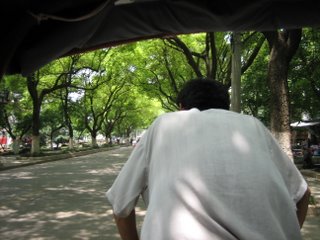Upon sight of the pale red dried Wolfberries that were passed around in class, I felt a familiarity for the specimens. I knew I had seen them before, but couldn’t recall the time or place. Upon finding them in Wikipedia and discovering that they are also know as the “Chinese Wolfberry, Duke of Argyll’s Tea Tree”, it dawned on me. I knew exactly where I had seen the nutrient rich berry- it was in the tea of so many locals I met in Shanghai on a recent trip. Most notably, a hard working older gentlemen who drove a bicycle powered rickshaw. The rickshaw must have been 50 years old and heavy in its own right. The man looked to be over 60. With the added weight of my 200 pound husband plus me (weight undisclosed), the skinny, seemingly malnourished man strained to pull us. At one point, uphill, across a busy boulevard, he had to get off his bicycle to walk the rickshaw. I wanted to get out and push, but he would not let us. I suppose it was his only way to make a buck. If he had been able to read Chinese characters, he would have taken us to the nearby silk museum, but instead, he pedaled us way across town to a silk factory. He offered to take us back after he realized that was not where we intended to go, but we couldn’t bear to see him struggle to pedal us again. Little had I known at the time about the power of the Wolf berry…perhaps I should have taken that ride.
The Wolfberry, also known as Goji berry or Tibetan Goji berry, and Frutus Lychi (as it was named on the package I bought from May Wah), can be eaten raw or cooked. It is often used in tea, as I had witnessed in Shanghai, and in soups. They are rich in nutrients such as beta-carotene, lutein, and lycopene; contains vitamins C, B1 and B2 to name a few, and contains more than 30 essential and trace minerals, antioxidants, and amino acids. It is known in Traditional Chinese Medicine to boost the immune system, eyesight, sperm production and improve circulation among other benefits.
I found the Frutus Lychi at May Wah sold by itself in the aisle with other dried foods and in packages combined with dried mushrooms, herbs and bark that appeared to be herbal elixirs. (There was a tea pot on the package showing that you needed to steep the mixture) I would have purchased one of these, but there was no way of knowing what the desired remedy was, and I feared an unwanted result. I tried adding the plain Wolfberry while steeping my green tea, but didn’t notice any obvious added flavor. When eaten, it seemed drier than a raisin with a similar fruity taste, but not nearly as sweet. Considering the nutrient content alone, I think I will continue to add the Wolfberry to my teas and perhaps at an old age I too will have the strength to pull two heavy Americans around on a rickshaw.

Here's a picture taken from the rickshaw of the poor Chinese man who struggled to pull us.
No comments:
Post a Comment